Three years in the making

In March 2017 I purchased the Diamond NR770HBNMO 2m/440 antenna with K515SNMO mount for my 2015 Subaru Forester. This was a last minute purchase for use in the Virginia QSO Party (VAQP) as VHF+ mobile operation. The mount literally arrived at my QTH Saturday morning one hour before the start of the event. Install was painless. Needless to say the antenna worked wonderfully well leading to my first VAQP plaque (right) and to this review.
Since this initial success, this antenna and mounting combination have been my daily driver 2m/440 mobile solution. Results have been quite satisfying. Definitely a solid upgrade from the previous relatively short dualband magnetic mount solution.
This article shows initial installation particulars along with an update three and a half years later.
The Diamond Antenna K515SNMO luggage rack mount
Let’s start with Diamond Antenna luggage rack (roof rail) mount.

This nifty mount makes short work of adding an aerial to any vehicle with a sturdy luggage rack or roof rails. It comes with 13.5 feet of RG-316 coaxial cable and provides a universal NMO mount point. Note: UHF connector version is also available.

The K515 style comes with brackets, hardware and a bit of rubber gasket material. The instructions claim the rubber ensures electrical isolation between the mount and the vehicle emphasizing this product is only for “groundless” antenna styles. A side benefit is protection of the roof rail paint finish.
What constitutes a groundless antenna design you ask?
Groundless antennas?
The end-fed halfwave antennas that permeate the antenna industry are the clear choice for ground-isolated mounts. The K515SNMO above forces “ground” isolation at least at DC. Antennas designed for non conductive structures, like many VHF marine antennas, are often end-fed halfwave designs or variations thereof.
The key feature of all these designs is the very low “counterpoise” current. This greatly reduces the need for a robust electrical conductive path for the coaxial shield currents that are busy energizing a low to high impedance transformer. I’ve performed lots of research and have much to say concerning end-fed antenna designs.
Questionable documentation and some blatant redesign fails aside, Diamond Antenna shows they know what they are doing most of the time with regard to actual antenna design. They are no stranger to end-fed approaches including a 2m/440 model compatible with the K515SNMO mount.
Diamond Antenna NR770HBNMO dual band antenna
The NR770HBNMO is a sturdy solid black wire design with a relatively large 3/4 by 3-1/2 inch (19 x 89mm) auto transformer at the base. This transformer performs the conversion from 50 ohms to the high impedance at the base of the wire resulting from end feeding the single halfwave antenna element at 2m and double collinear at 70cm. Here is a photo of the new antenna atop the K515 mount. This eventually replaced the shorter mag mount antenna to the right.

The K515 mount’s RG-316 cable uniquely terminates to an SMA connector.

The mount comes with an SMA to UHF converter to keep things simple for connection to most mobile rigs.
Unassuming appearance
The black finish of the antenna and mount plus overall sleek appearance help this Diamond 2m/440 mobile solution blend in like a stock antenna.

Well almost. It’s certainly much less in your face than that EZPass transponder.
Note the antenna is also available in metallic finish as the NR770HNMO. If you like your mobile antennas to “bling” your ride, well here you go.
Measurements
2017 VNA measurements confirm excellent tuning for both 2m and 440.
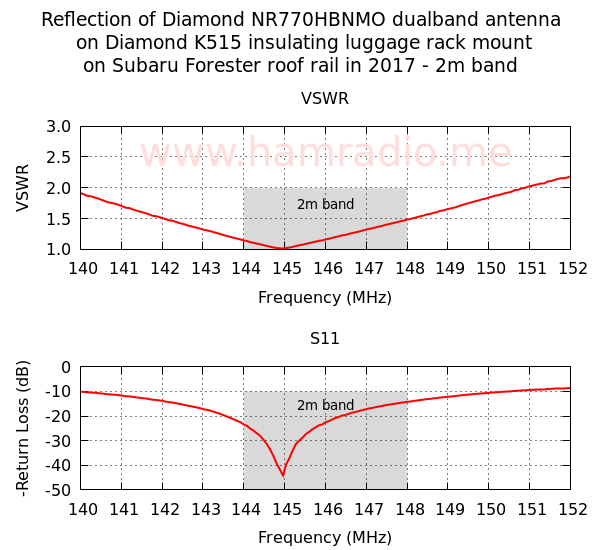
It’s a tad low on 2m, but provides a great match across the entire band.

The antenna and mount nail the tuning for the 70cm band right in the middle of the FM segment.
K515SNMO mount cable routing
You haven’t really lived till you’ve installed nice thin coaxial cable in your mobile. I did confirm one key characteristic of the RG-316… a magnet test confirms steel core center conductor. So at least it passes that test to suggest this really is real 316. Here is a recent photo of the cable routing of my K515 routed alongside a later 6m antenna line.
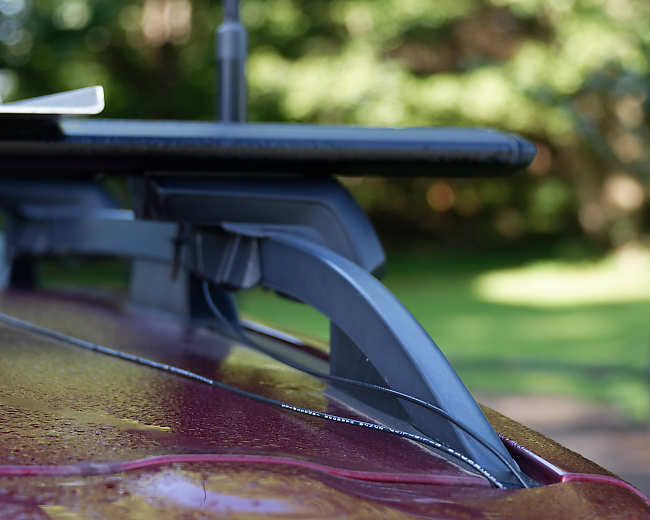
More closely…

From here it nestles just outside the weather seal of the hatch area and crosses it at the bottom (drip loop). From there it heads inside and along the usual paths all easily tucked under plastic trim. Here is the end of the road underneath the front passenger seat.

You always wonder if the provided cable length will be enough, but it was in this mid size SUV… barely. Yes the antenna placement towards the rear of the roof rail was required to allow the 13.5 foot feedline to reach the transceiver.
Observations
I performed a lot more measurements and operational observations in another post on this site…
I won’t repeat all the details except to say this was a solid upgrade from that mag mount, especially at 70cm, as these measured patterns make clear.

Highlights include…
- Commendable 2m operation especially given the height provided by the SUV.
- Stunning 70cm performance thanks to the collinear nature of the antenna helpfully compensating for the additional loss in the RG-316.
Keep that transformer in the clear
The long transformer at the bottom of the antenna has high impedance at its top and along much of its length. Any dielectric loading on or near this area will severely detune the antenna. Keep all conductors, plastics, everything well away from any antenna high impedance point including this transformer.
Three years later
Here is how the antenna base looks after a good long run on my daily driver, about a dozen treks to Maine and a few excursions to salty OBX…

There is some noticeable corrosion at the NMO interface. I can no longer unscrew the two with bare hands. Here’s a closer look at the NMO interface.
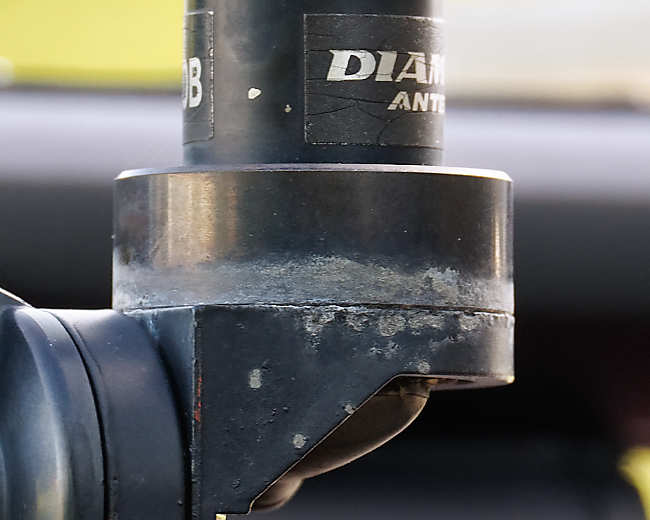
It likely makes sense to apply some sort of electrical grease at this interface to prevent what we see above. The antenna still performs well electrically and remains mechanically solid. I never paid attention to the metals of the mount and antenna. I do wonder if they are dissimilar metals. Perhaps the paint or equiv. is simply disturbed by the abrasion of fastening the antenna in place providing corrosion a place to start.
The antenna takes a beating from Mother Nature…
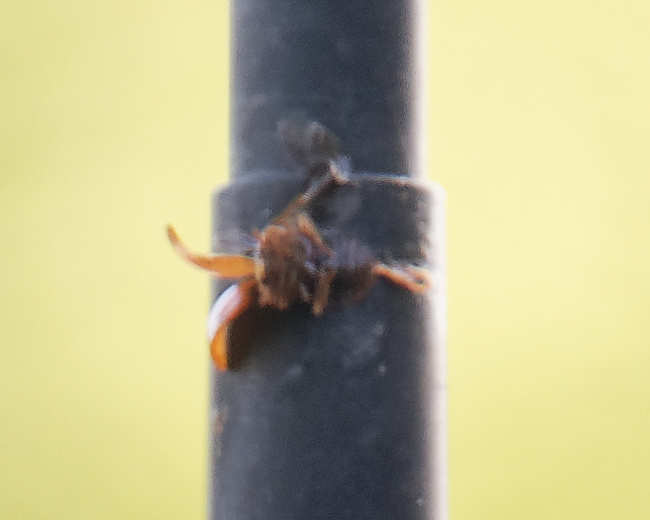
I don’t know what this is, but it didn’t effect the operation of the antenna. Every day there’s something new to see.
Recent VSWR measurement
I took the MFJ out for a measurement on 2m only. The overall frequency of the antenna moved down from 145 to about 143 MHz. At 148 MHz, the MFJ reports a worst case VSWR about 1.6. This is still fine, but do wonder about the change. I borrowed a VNA to retake reflection measurements to compare with the previous.


One key difference between 2017 and 2020 is the addition of sturdy cross bars to my rails.

Everything is still in the clear, but I’d be surprised if the new bars didn’t have some effect on every antenna on the roof including this 2m/440. We’ll explore this in a future article.
Bonus: Nice to see the affordable MFJ VSWR meter in reasonable agreement with a laboratory grade VNA.
Antenna and mount are prefect companions
Mechanically this antenna/mount combination has been wonderful. I’ve hit my fair share of limbs, a bird, etc. with no perceivable effect on the antenna. The continuous whip including the midpoint coil counts for much of this robustness. The K515 mount mercifully gives a bit if you hit something hard. This mechanical fail safe is simple and works very well. The mount includes a tension knob for lowering the antenna with ease. You can tighten this to taste governing how much give you need to hold the antenna up at driving speeds while giving way to obstructions.
The K515 easily supports the NR770 at highway speeds with no problems whatsoever. Antennas much taller than a meter will overburden this mount.
Antenna weak points
Electrically the high impedance coil could be a weak spot. I’ve seen some reviews of this and similar antennas where the matching capacitor involved in the matching circuit can fail. I’ve never run much more than ten watts so am probably not stressing this weakest point. The slight downward change of the SWR over 3.5 years could be an indication of an aging capacitor, but that’s just a guess as the new cross bars may also be to blame. The antenna still works well and that’s the important thing.
Low profile
Despite being on top of an SUV, the antenna’s max height is reasonable. This is important for my particular travels through NYC as the historic freeways often have stunningly low bridge clearances of 9 feet or less. The combination of my Forester and this antenna slide right through with no issues. Nice.
The Subaru Forester roof rail is a nearly ideal location for a 2m/440 mobile antenna. It’s sits well above most nearby traffic keeping a clear shot to other transceivers better than most installations. The counterpoise-less design alleviates the concerns of providing ample “ground” for this antenna.
Strong value
I investigated a much longer 2m antenna for QSO Party use.
This gave me a good opportunity to directly compare this NR770/K515 combination with the much taller NR22L 2m collinear monoband monster. Long story short, the impressively tall NR22L handily beats the shorter antenna, but only by about 2 dB on average. The top of the NR22L is right at the 13.5 feet roadway legal limit. Not being an end-fed high-impedance design, the NR22L requires a counterpoise or equivalent. The beastly plate I designed to mount it provides this plus a robust mechanical mount point. Given the additional complexity, the 2 dB advantage is, in my opinion, only of utility for the most esoteric applications such as a fun VHF contest. Of course any height over local obstacles is a welcome benefit, but as a daily driver, the NR770 dualband antenna system is a perfectly reasonable, more practical, and eminently satisfying compromise.
Conclusion
I love it. For several years my 2m/440 mobiling has been nearly transparent without having to think much about the radio-antenna combination. I have far more trouble with my microphone connector. Other than that… it just works.
If you have little to no roof conductor available for your antenna “counterpoise” then the Diamond NR770/K515 combination is for you.
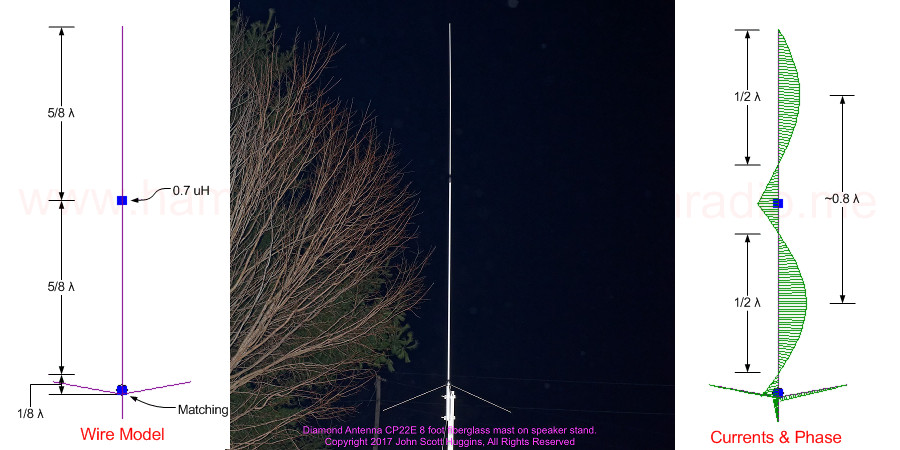







Another terrific analysis!
You state:
"The end-fed halfwave antennas that permeate the antenna industry are the clear choice for ground-isolated mounts".
By "ground isolated" do you mean "DC isolated or "RF isolated"? Because I would anticipate that the comet luggage rack mount is "DC" isolated. But then again, so is a mag mount with a rubber boot. But as you have so clearly shown, there is a certain amount of capacitive coupling (more at VHF and UHF) between the mag mount and the car roof. Would not the same capacitive coupling principal apply (albeit at a much lower level) with the ground isolated rack mount?
For this analysis, I am speaking of RF isolated. Of course DC and AC (RF) often go hand in hand, but for the sake of the antenna's operation and need, or no need, for ground currents to flow to the larger body, I mean RF.